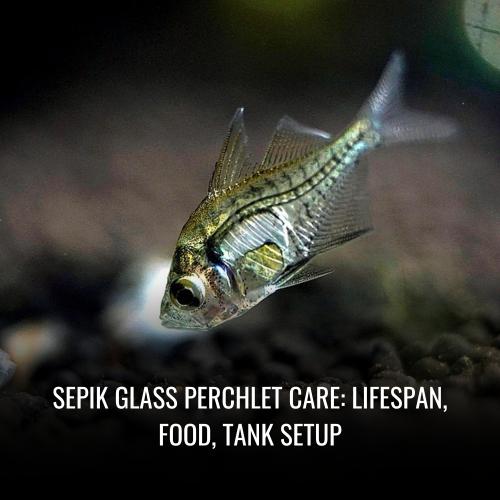The vibrant Madagascar Rainbowfish, known scientifically as Bedotia geayi and popularly as the Red-tailed Silverside, is a captivating species of fish cherished by tank fish keepers for its silver scales and animated behavior. Renowned for its adaptability, this peaceful fish is a schooling species, favoring the company of its kind, while also coexisting harmoniously with other peaceful tank mates.
Here is a quick profile of the Madagascar Rainbowfish:
| Aspect | Profile |
|---|---|
| Scientific Name | Bedotia geayi |
| Family | Bedotiidae |
| Usual Size in Tanks | 10-12 cm (4-4.7 inches) |
| pH Range | 6.5 – 7.5 |
| Water Hardness (dGH) | 5 – 15°N |
| Temperature | 18°C – 24°C (64°F – 75°F) |
| Reproduction | Oviparous |
| Origin | Madagascar |
| Tank Temperament | Peaceful to its own, peaceful with others |
| Tank Placement | Middle to Top |
| Lifespan | 3-5 years, up to 7-8 with care |
| Tank Size Requirement | 55 gallons minimum |
| Filtration System | High-quality, to mimic natural currents |
| Sexual Dimorphism | Yes, males more colorful |
| Substrate | Dark sand and gravel |
Captivated by the allure of Madagascar’s natural habitat, experienced fish keepers replicate a slice of the island’s flowing rivers. They maintain pristine water quality, adapting weekly water changes to ensure the wellbeing of these bold and unforgettable fishes. With their need for swimming spaces, Madagascar Rainbowfish thrive in larger aquariums with varied diets of brine shrimp, tubifex worms, and even water fleas.
Scientific Name
The Madagascar Rainbowfish, an enchanting freshwater fish, is scientifically known as Bedotia geayi. Classified under the family of Bedotiidae, this species possesses a unique charm that is native to the tranquil streams and rivers of Madagascar.
To summarize the scientific classification:
| Classification Level | Information |
|---|---|
| Scientific Name | Bedotia geayi |
| Family | Bedotiidae |
| Natural Habitat | Madagascar |
| Usual Size in Tanks | 10-12 cm (3.94-4.72 inches) |
| Preferred pH Range | 7 – 7.5 |
By strictly adhering to these parameters, aquarists can provide the Madagascar Rainbowfish with an environment that mirrors their native ecosystem, ensuring these radiant fish flourish in home aquariums.
Average Size
The captivating Madagascar Rainbowfish, known for their beautiful silver scales, often reach an impressive size in captivity. On average, these striking creatures measure about three to four inches in length. However, they have the potential to grow even larger, with some individuals attaining a length of up to 5.9 inches.
For a clear understanding of their size range, consider the following data on their standard length:
| Size Category | Standard Length (mm) |
|---|---|
| Max Length | 80 – 100 |
| Average | 75 – 95 |
To accommodate their active swimming habits, the minimum aquarium base should measure at least 120 by 30 cm. While a 30-gallon tank can work temporarily for a group of juvenile fish, a more extensive setup will be needed to provide these schooling fish the space they need as they grow.
Lifespan
Madagascar Rainbowfish, a species known not only for their rainbow iridescence but also for their bold behavior, have a moderate lifespan in captivity. Typically, fish keepers can expect these freshwater fish to thrive for 3 to 5 years, providing their water conditions and diet are well-maintained.
Below is a summary of the lifespan variations in Madagascar Rainbowfish:
| Lifespan Context | Expected Years |
|---|---|
| Average in Captivity | 3 – 5 years |
| With Optimal Care | up to 7 – 8 years |
| Affected by Genetics | Variable |
| Wild Counterparts | Lesser due to Predators and Diseases |
While their time in home aquariums can sometimes surpass the 5-year mark, the harmonious balance of pristine water quality, ample swimming space, a diet of frozen foods such as brine shrimp and tubifex worms, and stable water parameters ensures these rainbow fish species make their tank fish keeper’s efforts unforgettable.
Natural Habitat
Endemic to Madagascar’s pristine Mananjary River, the Madagascar Rainbowfish has carved out its territory in the island’s diverse ecosystem. These radiant fish are often found in the calmer realms of shaded, flowing streams, and they appreciate the tranquil lower river stretches that meld gently into coastal lagoons and lakes.
Key Aspects of Their Native Environment:
| Aspect | Details |
|---|---|
| Altitude | Around 500 meters above sea level |
| Temperature | Tropical waters; 75 – 85°F |
| pH Range | 6.5 to 8.5 |
| Adaptability | Tolerant of South American (lower acidity) & African (higher alkalinity) water conditions |
Their very survival speaks to a delicate harmony, with the water surface often mirroring the beauty of their iridescent, silver scales.
Appearance
Madagascar rainbow fish are a testament to nature’s artistry, typically measuring a modest 5 to 6 inches but displaying a stunning array of colors. Encased in sleek, elongated bodies, their fins are often highlighted with vivid shades, especially red, which create a striking contrast against their bodies.
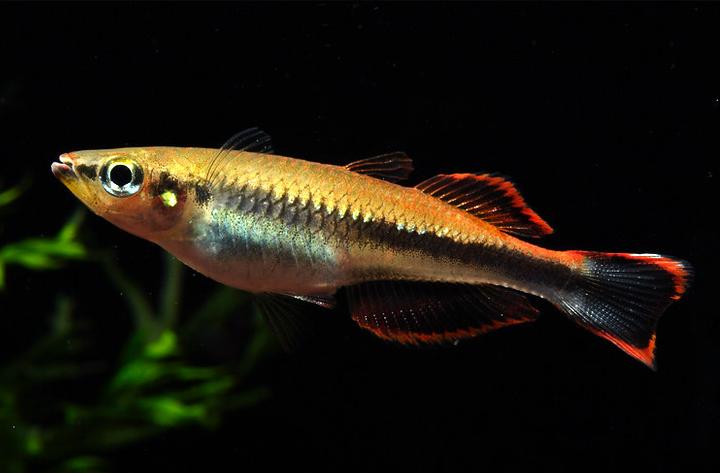
Among the many jewels in the Madagascan waters, two species captivate fish keepers particularly:
- Bedotia geayi: This species is an underwater kaleidoscope, displaying a mesmerizing mix of blue, green, and yellow hues.
- Bedotia marojejy: It stands out with its unique black and white patterns that command attention.
A glimpse into a tank of Madagascar rainbow fish reveals more than visual splendor:
| Species | Notable Colors |
|---|---|
| General Population | Varied Hues |
| Bedotia geayi | Blue, Green, Yellow |
| Bedotia marojejy | Black and White |
These rainbow fish are more than just inhabitants of freshwater tanks—they are living, swimming canvases that transform aquariums into dynamic displays of natural beauty. Their bold and peaceful nature makes them perfect for creating unforgettable underwater scenes, especially in community tanks where their coloring can truly shine.
Behavior & Temperament
Madagascar rainbowfish are a peaceful and gregarious species that embody the subtler side of aquatic behavior. Their gentle demeanor sets them apart in the freshwater community, making them not only a visual delight but also a harmonious addition to a tank.

Are Madagascar rainbowfish Fin Nippers?
Unlike some other species of fish that can exhibit aggressive fin-nipping behavior, Madagascar rainbowfish are known for their peaceful interactions. They do not take part in the harmful practice of fin-nipping, allowing them to cohabitate with a variety of other fish without causing undue stress or injury.
Are Madagascar rainbowfish Aggressive To Each Other & Other Fish?
Madagascar rainbowfish maintain a congenial temperament within their shoals and among other tank mates. While males may showcase more striking coloration and finnage, this display is not a precursor to aggression. Occasional squabbles may occur within a group but are typical of their social structure rather than a sign of overt hostility. Ensuring adequate swimming spaces and a well-structured environment can further reduce any minor conflicts.
Are Madagascar rainbowfish Friendly To Each Other & Other Fish?
Reflecting their peaceful nature, Madagascar rainbowfish are amicable both towards their own kind and other fish sharing their habitat. They thrive in groups where they can exhibit their natural shoaling behavior, making them excellent candidates for community aquariums. Tank mates of comparable size and temperament, such as Australasian Rainbowfish, characids, peaceful cichlids, barbs, and catfishes, will find a harmonious companion in the Madagascar rainbowfish.
Are Madagascar rainbowfish Schooling Fish?
Indeed, Madagascar rainbowfish exemplify the principle of strength in numbers. As schooling fish, they seek the company of at least six individuals to feel comfortable and secure. An ideal group size is twelve or more to fully appreciate their collective dynamics, as it replicates their instinctive behavior in Madagascar’s riverine systems. Larger schools can also amplify the collective beauty of their vibrant colors and natural schooling behavior.
Can You Have Just One Madagascar rainbowfish In The Tank?
While it’s technically possible to house a single Madagascar rainbowfish, such a choice would be contrary to their social nature and could lead to stress and diminished zest for life. A solitary Madagascar rainbowfish may display subdued coloration compared to those kept in schools. For the well-being of the fish, a minimum of six individuals is recommended to allow them to exhibit their full behavioral portfolio and maintain optimal health.
Do Madagascar rainbowfish Need To Be In Groups?
To echo their life in the wild, Madagascar rainbowfish are happiest and healthiest when kept in groups. A solitary existence for these schooling fish can lead to stress, loneliness, and a decrease in the natural vibrancy they are famed for. A group with the suggested number of fish not only ensures a more serene and natural environment but also allows the Madagascar rainbowfish to engage in the kind of intricate social interactions that define their species.
Food & Diet
Madagascar rainbowfish, scientifically known as Bedotia geayi, present an alluring addition to the aquarium due to their dazzling silver scales and vivacious behavior. These fish, native to the island of Madagascar, have adapted to a varied diet in their natural habitat, making them a versatile species for fish keepers. To keep these freshwater fish in optimal health, understanding their dietary needs is essential.
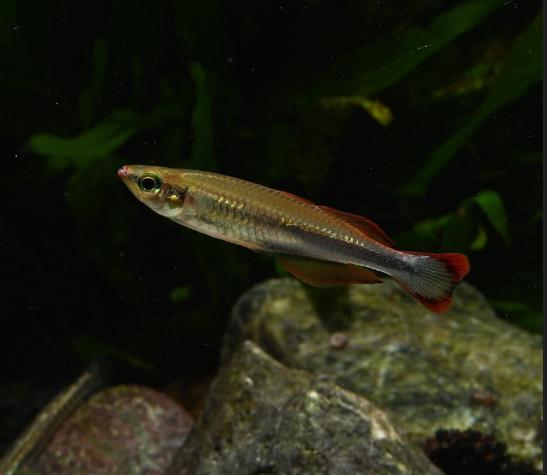
Do Madagascar rainbowfish Eat Algae?
In the wild, the Madagascar rainbowfish’s omnivorous diet includes algae as part of their intake. In captivity, they can be offered algae pellets, which contribute to their plant-based nutritional requirements. The ingestion of algae is beneficial for this species, providing essential nutrients that contribute to their health and natatory vigor.
Do Madagascar rainbowfish Eat Shrimp?
As part of their omnivorous diet, Madagascar rainbowfish savor small invertebrates, with shrimp being a delectable treat. They thrive on a diet that includes high-quality pellets and flakes, while occasional offerings of brine shrimp serve as a nutritious supplement. When fed in moderation, shrimp contribute to the diversity of their diet and ensure they receive a well-rounded array of nutrients.
Do Madagascar rainbowfish Eat Bloodworms?
Bloodworms are another high-protein food source that Madagascar rainbowfish can relish. These worms provide sustenance that supports the health and coloration of these iridescent creatures. Frozen bloodworms can substitute live ones and should be offered in conjunction with other live or frozen foods to maintain dietary variety and ensure the rainbowfish’s well-being.
Do Madagascar rainbowfish Eat Mosquito Larvae?
Mosquito larvae naturally appear in the diet of Madagascar rainbowfish in their indigenous environment and can be included in their meals within an aquarium setting. These larvae provide enrichment that simulates their instinctive foraging habits. Feeding rainbowfish mosquito larvae alongside their standard fare can aid in replicating a more authentic dining experience and encourage active behaviors.
Do Madagascar rainbowfish Eat Planaria?
While Madagascar rainbowfish may occasionally consume small invertebrates like planaria, it is vital to balance their diet with other nutrients. A staple of high-quality flakes and pellets, augmented with a cornucopia of live or frozen foods, helps ensure they receive the full spectrum of their dietary needs. Responsible feeding practices, such as providing food in small, manageable quantities, can prevent potential health issues related to overfeeding.
Do Madagascar rainbowfish Eat Plants?
Vegetation forms a considerable part of the Madagascan Rainbow Fish and Red-Tailed Silverside diet in their natural lived experience. In the confines of an aquarium, these fish appreciate a diet supplemented with plant-oriented foods such as ground vegetables or spirulina flakes. Introducing plant matter into their regimen encourages robust health and can enhance the vibrant, unforgettable colors that make these fish a bold and peaceful centerpiece in aquarium communities.
By embracing these feeding principles and offering a diverse menu, fish keepers can ensure their Madagascar rainbowfish not only survive but thrive in their aquatic domains. Healthy and well-fed Madagascar rainbowfish radiate vitality, adding a sparkle of life to any tank that’s hard to forget. Whether they are foraging for mosquito larvae at the water surface or grazing on soft algae, the Madagascar rainbowfish’s diverse diet cements their status as an unforgettable and engaging species to keep, for both experienced and novice tank fish keepers.
Sexing: Male vs Female
Distinguishing between male and female Madagascar rainbowfish is quite straightforward given their distinct sexual dimorphism. Adult males display a more extensive color palette along with enhanced fin hues, making them the more flamboyant sex. Specifically, male fins are resplendent with color, and their first dorsal fin is characteristically more pointed.
| Male Madagascar Rainbowfish | Female Madagascar Rainbowfish |
|---|---|
| Extensive range of colors | Less colorful |
| Colorful fins and tail | Plainer fins and tail |
| Pointed first dorsal fin | Rounded first dorsal fin |
| Leaner body shape | Plumper body shape (especially with eggs) |
This difference in appearance between the sexes not only eases the process of sexing but also adds a dynamic visual element to the natural display within the aquatic habitat. By observing these visual cues, fish keepers can easily identify the gender of their Madagascar rainbowfish, which is essential for breeding planning.
Madagascar rainbowfish Tank Mates
When selecting tank mates for the peaceful Madagascar rainbowfish, it’s crucial to aim for species that share their calm demeanor. Ideal companions include smaller, non-aggressive fish like Boeseman’s Rainbowfish, Turquoise Rainbowfish, and the vividly colored Tetras—Neon, Cardinal, and Rummy Nose. Harlequin Rasboras and Pearl Gouramis also make excellent neighbors in the tranquil aquatic community.
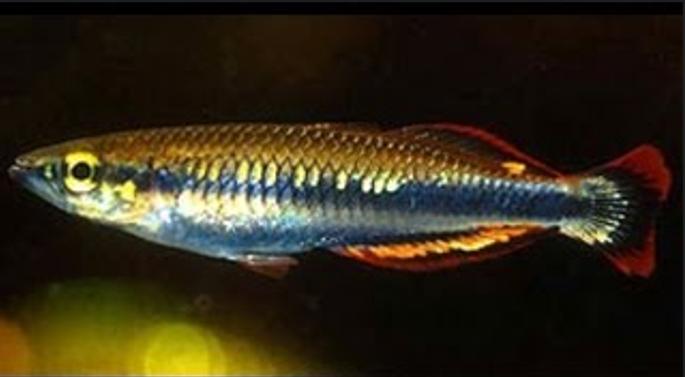
These schooling fish flourish in groups, reminiscent of their natural behavior in the wild, where they travel in shoals of a dozen or more. In aquarium settings, strive to house them with at least six of their kind, space permitting, to emulate their preferred social structure.
Compatible Tank Mates for Madagascar Rainbowfish:
- Boeseman’s Rainbowfish.
- Turquoise Rainbowfish.
- Neon Tetra.
- Cardinal Tetra.
- Rummy Nose Tetra.
- Harlequin Rasbora.
- Pearl Gourami.
- Barbs.
- Danios.
- Larger Tetras.
Remember to maintain water quality with weekly water changes and monitoring water parameters to foster a vibrant and healthy ecosystem where these delightful fish can swim freely in the middle to upper levels of their aquatic home.
Aquarium Setup
Setting up the perfect habitat for Madagascar rainbowfish requires detailed attention to their spacious swimming needs and water quality to mirror their natural environment. A well-planned aquarium does not only serve as a home for these striking fish but also as a captivating living art piece. The optimal setup involves considering tank size, water parameters, filtration, and lighting.
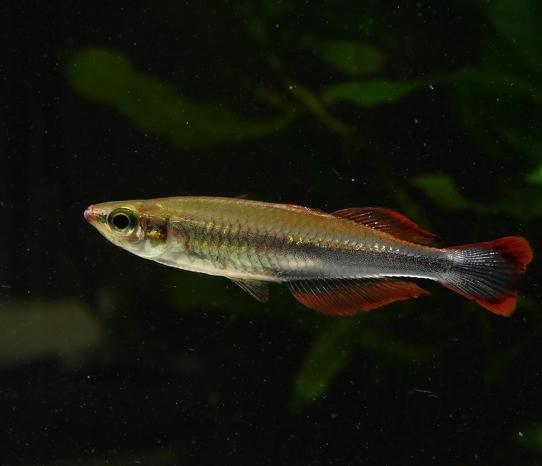
Ideal Tank Size
Madagascar Rainbowfish are dynamic swimmers that flourish in larger tanks. A minimum tank capacity of 30 gallons is essential, allowing adequate space for a small group to swim. Juvenile fish and smaller groups may start in this environment, but to truly cater to their growth and sociable nature, a tank ranging from 100 to 150 gallons is advisable for adult fish.
For those seeking to create a resplendent school of Madagascar Rainbowfish, an expansive tank of around 400 liters can comfortably support a group of 10, offering them vast swimming spaces. This sort of tank not only benefits the fish but becomes a focal point for any room.
Ideal Water Parameters
Water quality is paramount for maintaining the health and coloration of the Madagascar Rainbowfish. These fish require freshwater with a pH range of 6.5 to 8.5, showcasing their adaptability. The ideal temperature for their well-being is between 72 to 77 degrees Fahrenheit (22 to 25 degrees Celsius), replicating the thermal conditions of their endemic Mananjary River.
The preferred general hardness (GH) should be between 8 to 25, serving the mineral requirements of Madagascar Rainbowfish. A manageable total dissolved solids (TDS) range of up to 268 also allows some flexibility, accommodating fish keepers with various water sources.
Regular Aquarium Maintenance:
- Weekly water changes of 25-50%
- Monitoring of water parameters for deviations
It is essential to implement steps such as using heat pads and careful filter head adjustments to reduce water flow and avert evaporation, aiming to sustain prime water conditions.
Filtration
Madagascar Rainbowfish thrive in a well-oxygenated tank with clean water. Canister filters are highly recommended due to their dual functions: mechanical and biological filtration. These filters can be customized with various filter media to suit the necessities of the aquatic habitat.
Filter Media Types
- Mechanical.
- Biological.
A larger-than-average filtration system is necessary to accommodate these active fish, with weekly water changes being indispensable to preserve optimal water parameters. Mechanical media captures debris, preventing clogs, while biological media supports the nitrogen cycle, keeping ammonia and nitrite levels in check.
Lighting
Proper lighting not only invigorates the Madagascar Rainbowfish’s vivid coloration but is crucial for any live plants present in the aquarium. An ideal lighting regimen would consist of 2 to 4 watts per gallon, following the natural day-night cycle with an illumination period of 8-10 hours daily.
When considering plant life for the aquarium, Aponogeton species are fitting candidates. These plants are native to Madagascar and able to prosper in both low to moderate light settings. They tolerate a wide temperature range and a pH level typically around 7.0 but can adapt to slightly more acidic or alkaline waters.
In essence, a deliberate and thorough aquarium setup ensures that your Madagascar Rainbowfish not only survive but thrive, presenting an unforgettable spectacle of natural beauty within your home.
Common Possible Diseases & Prevention
Madagascar rainbowfish, with their captivating silver scales and active swimming, can encounter health issues like any freshwater fish. Awareness and rapid response to symptoms are key to their well-being.
| Common Diseases | Symptoms | Treatment |
|---|---|---|
| Ich | White spots, itching, behavioral shifts | Antiparasitic medication |
| Fungal Infections | Cotton-like growths | Antifungal medications |
| Bacterial Infections | Varies depending on infection type | Antibacterial medications |
To stave off Ich, observe for unusual spots and signs of distress, known as flashing. Fungal infections, with tell-tale cottony patches, need immediate antifungal attention. Bacterial infections are diverse and can severely affect the fish if untreated, calling for prompt antibiotic care.
Maintaining the habitat meticulously with stable water conditions—72 to 77°F temperature, proper pH, and oxygenation—is critical. Weekly water changes of 25-50% and monitoring for changes in water parameters keep diseases at bay. A well-maintained tank not only prevents illness but also ensures these rainbow fishes continue to dazzle as a bold and peaceful centerpiece in any aquarist’s collection.
Breeding Madagascar Rainbowfish in Aquarium
Breeding the alluring Madagascar rainbowfish in your home aquarium is an exciting endeavor but demands a carefully prepared environment. To pave the way for successful reproduction, you’ll need an established tank that offers dim to moderate lighting, ample open swimming spaces, and a secure lid to keep fish safe.
| Breeding Tank Requirements | Details |
|---|---|
| Tank Size | At least 24 inches |
| Filtration | Sponge filter |
| Decor | Vegetation, rocks, wood for hiding |
Ensure the spawning tank is furnished with a sponge filter and adorned with enough vegetation, rocks, or wood to provide solace for the females. Introduce a small breeding group, typically one male to every two or three females of comparable size, to trigger the spawning ritual.
Are Madagascar rainbowfish Easy To Keep?
Madagascar rainbowfish are renowned for their resiliency and vibrant hues, making them a delightful asset for both novice and seasoned aquarium hobbyists. They exhibit a forgiving nature regarding water conditions, thriving within a temperature range of 73.4-77.0°F (23.0 to 25.0°C), a pH range of 6.5-8.5, and a hardness range of 8 – 25 dGH. These adaptable freshwater fish can effortlessly adjust to community tanks, given that their tankmates match them in size, temperament, and activity.
To flourish, Madagascar rainbowfish require companionship, often preferring the company of at least six conspecifics to feel at ease. Their schooling behavior ensures a dynamic tank environment, with minimal intraspecific conflict. The fish display even more extraordinary colors and intriguing behaviors during courtship, turning the aquarium into a compelling aquatic exhibit. With the right tank conditions, a suitable group size, and compatible neighbors, Madagascar rainbowfish are undoubtedly effortless and rewarding charges for tank fish keepers.
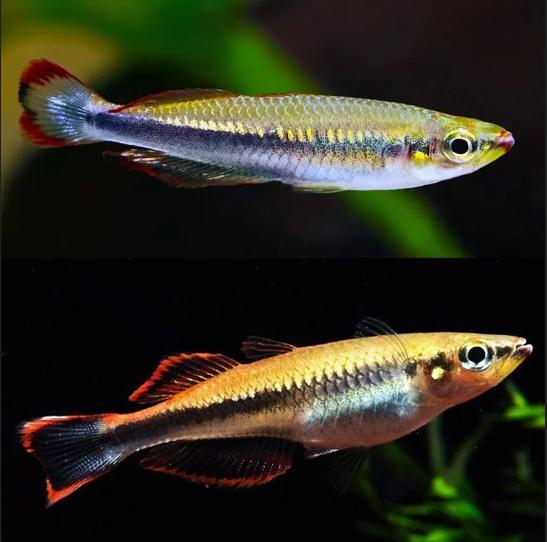
Are Madagascar rainbowfish Sensitive To Water Changes?
Madagascar rainbowfish hail from areas in their native habitat that feature shaded waterways teeming with lush vegetation and insects, hinting at their preference for specific water environments. As active swimmers, these fish revel in aquariums that mirror the gentle river currents they are adapted to. This requires a thoughtful tank set-up with multiple powerheads to maintain moderate water movement without compromising their need for ample swimming spaces.
Are Madagascar rainbowfish Sensitive To Ammonia?
Madagascar rainbowfish, sporting their shimmering silver scales and peaceful nature, are intolerant of subpar water conditions, especially the presence of nitrites and ammonia. They must reside in water that remains untainted and undergoes regular purification. This makes them ill-suited to newly cycled tanks where the biological filtration may not be fully established. Fish keepers should adhere to stringent water quality management, including regular water changes—ideally on a weekly basis—to sustain water parameters, with nitrates maintained below 15 ppm.
It’s noteworthy that these fish are excellent bio-indicators. Their coloration can fade as a sign of distress when exposed to poor water quality. An essential part of their care involves vigilance with pH levels, as any sudden variations can precipitate stress or physical complications. This underscores the significance of a mature, well-maintained tank for the well-being of Madagascar rainbowfish.
Are Madagascar rainbowfish Sensitive To Copper?
Among the various factors critical to the survival and health of Madagascar rainbowfish, their tolerance to copper stands out. Copper, often found in trace amounts in tap water, poses a serious threat to these magnificent creatures. Even insignificant copper exposure can exacerbate stress, weaken their immune response, and prove fatal over time. It is imperative that water conditioners, which neutralize copper content, be employed prior to the introduction of these fish to the tank.
The usage of copper-based medications in an aquarium housing Madagascar rainbowfish should be strictly prohibited due to their potential lethality. Fish keepers need to be diligent, frequently testing water to monitor copper levels and maintaining minimal concentrations to safeguard the survival of these sensitive tank residents. Adhering to this preventative measure further certifies that the Madagascar rainbowfish remain a colorful, peaceful, and unforgettable fish species in the aquatic community.


